Are you ready to embark on a tropical taste adventure? Look no further than the camachile! This exotic fruit is a true delight for fruit lovers, offering a unique and delightful flavor. Whether you enjoy it fresh, in jams and jellies, or as a key ingredient in your favorite recipes, camachile is sure to tantalize your taste buds.
Key Takeaways:
- Camachile is a tropical fruit known for its unique and delightful flavor.
- It can be used in various dishes and recipes, adding a tropical twist to your culinary creations.
- Camachile is packed with health benefits, including fiber, antioxidants, vitamins, and minerals.
- It has a rich history in traditional medicine, with its anti-inflammatory and antimicrobial properties.
- Growing your own camachile tree is possible with the right climate and care.
The Camachile Tree: A Beautiful and Fruitful Plant
The camachile tree is a stunning plant that not only adds beauty to tropical landscapes but also yields the delightful camachile fruit. It is native to tropical regions and is characterized by its vibrant green foliage and eye-catching yellow flowers. The tree’s elegant appearance makes it a popular choice for gardens and parks, while its fruit offers a delicious taste that captivates fruit enthusiasts.
To ensure the healthy growth of a camachile tree, it requires specific care. The tree thrives in warm weather and prefers well-drained soil. Adequate sunlight is essential for the tree to flourish and produce an abundance of fruit. Regular watering is necessary, especially during dry periods, to keep the tree hydrated and promote optimal growth. Occasional pruning helps maintain the tree’s shape and encourages new growth.
When fully matured, the camachile tree bears clusters of small, oval-shaped fruits. These fruits have a smooth, pale yellow skin and a fleshy pulp that surrounds the seed. The flavor of camachile fruit is tangy and slightly sweet, making it a delicious addition to various culinary creations. From jams and jellies to desserts and beverages, the camachile fruit adds a unique twist to both sweet and savory dishes.
Interesting Facts about the Camachile Tree
- The camachile tree belongs to the Fabaceae family, which is the same family as the acacia tree.
- It is known by different names in various regions, including “katuray” in the Philippines and “guamúchil” in Mexico.
- The tree can reach a height of up to 25 meters, making it an impressive addition to any landscape.
- Camachile trees have the ability to fix nitrogen in the soil, which improves its fertility and benefits surrounding plants.
- The bark of the camachile tree has medicinal properties and is used in traditional medicine to treat various ailments.
Table: Camachile Tree Care
| Aspect | Requirement |
|---|---|
| Climate | Warm and tropical |
| Soil | Well-drained |
| Sunlight | Adequate sunlight |
| Watering | Regular watering, especially during dry periods |
| Pruning | Occasional pruning to maintain shape and stimulate growth |
The Versatility of Camachile: A Culinary Delight
Camachile is a versatile fruit that can be used in various culinary creations. Its tangy and slightly sweet flavor adds a unique twist to both sweet and savory dishes, making it a favorite among chefs and food enthusiasts. From refreshing beverages to exotic sauces, the uses of camachile are endless.
One popular way to enjoy camachile is by eating it fresh. Its juicy flesh and slightly tart taste make it a refreshing snack on a hot day. You can also add camachile to salads to give them a tropical flair. The vibrant color and distinct flavor of camachile can take your salad to the next level.
If you have a sweet tooth, you’ll love the various camachile dessert recipes available. Camachile can be used to make jams, jellies, and even pies. Its natural sweetness enhances the taste of these treats, creating a delightful balance of flavors. Whether you’re making a jam to spread on toast or a pie to enjoy after dinner, camachile will surely impress your taste buds.
For those who prefer savory dishes, camachile can be incorporated into sauces and marinades. Its tangy flavor adds a delightful kick to meats and seafood. You can use camachile as a base for a tangy barbecue sauce or add it to a marinade for grilled chicken or shrimp. The possibilities are endless when it comes to creating savory dishes with camachile.
Table: Ways to Use Camachile in Culinary Creations
| Dish | Description |
|---|---|
| Camachile Jam | A sweet and tangy spread that can be enjoyed on toast or pastries. |
| Camachile Salad | A refreshing salad with a tropical twist, perfect for a light lunch or side dish. |
| Camachile Barbecue Sauce | A tangy sauce that adds a burst of flavor to grilled meats and vegetables. |
| Camachile Pie | A delicious dessert with a flaky crust and a sweet filling made from camachile. |
| Camachile Marinade | A flavorful marinade that enhances the taste of grilled meats and seafood. |
As you can see, camachile is a versatile fruit that can elevate any dish. Whether you’re a fan of sweet or savory flavors, camachile is sure to delight your taste buds. So go ahead and explore the endless possibilities of camachile in your culinary creations.
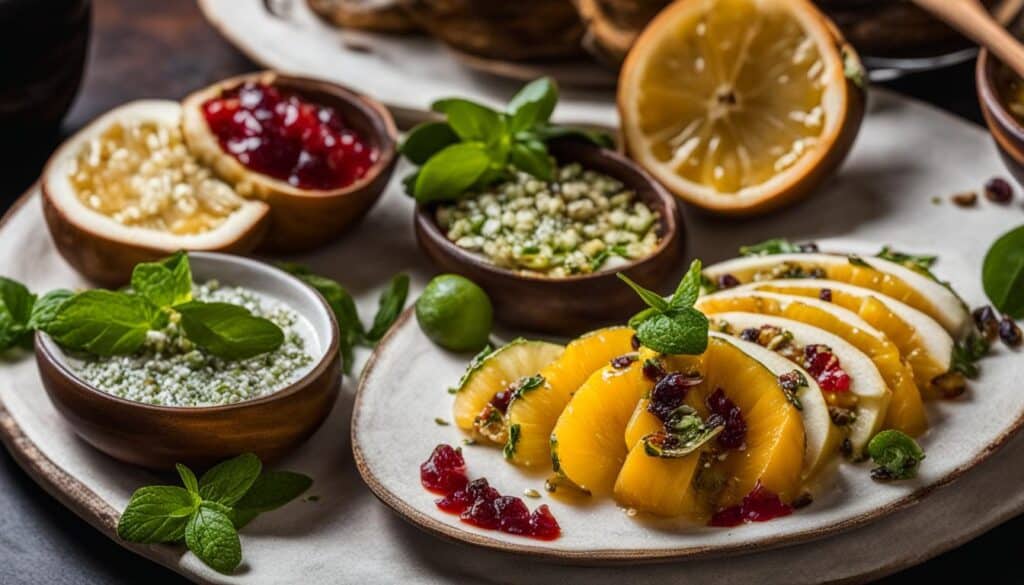
Health Benefits of Camachile: A Nutritional Powerhouse
Camachile is not just a delicious tropical fruit; it is also packed with numerous health benefits. Incorporating camachile into your diet can provide you with a range of nutrients that contribute to overall well-being. Let’s explore the nutritional powerhouse that camachile truly is.
First and foremost, camachile is an excellent source of dietary fiber. Fiber is essential for maintaining a healthy digestive system and promoting regular bowel movements. It helps prevent constipation and supports the growth of beneficial gut bacteria, improving overall gut health.
In addition to fiber, camachile is rich in antioxidants, vitamins, and minerals. It is particularly high in vitamin C, which strengthens the immune system and helps protect against various illnesses. Vitamin C is also an important antioxidant that fights free radicals, reducing the risk of chronic diseases.
Did you know?
Camachile contains iron, a mineral that plays a vital role in carrying oxygen throughout the body. Iron is essential for the production of hemoglobin, the protein in red blood cells that carries oxygen to tissues and organs.
Furthermore, camachile provides important minerals like calcium, which is crucial for maintaining strong and healthy bones. Adequate calcium intake helps prevent osteoporosis and keeps your skeletal system strong and resilient.
| Nutrient | Amount per 100g |
|---|---|
| Fiber | 4g |
| Vitamin C | 20mg |
| Iron | 1.2mg |
| Calcium | 28mg |
As you can see, camachile is a nutritional powerhouse with a range of health benefits. From its high fiber content to its antioxidant and mineral-rich profile, camachile is a tropical treat that nourishes your body from the inside out.
Camachile in Traditional Medicine: A Natural Remedy
Camachile has been valued for its medicinal properties in traditional medicine for centuries. It is believed to possess anti-inflammatory and antimicrobial effects, making it a go-to natural remedy for various ailments.
| Condition | Traditional Use |
|---|---|
| Skin Infections | Camachile is commonly used topically to treat skin infections, such as wounds, cuts, and rashes. Its antimicrobial properties help combat bacteria and promote healing. |
| Digestive Issues | The fruit is also known for its digestive benefits. Camachile is believed to alleviate stomachaches, indigestion, and bloating. It is often consumed as a tea or brewed with other medicinal herbs. |
| Anti-Inflammatory | Camachile has been used to alleviate inflammation in conditions such as arthritis and gout. Its anti-inflammatory properties may help reduce pain and swelling. |
While camachile has a long history of use in traditional medicine, it is important to note that scientific studies on its medicinal properties and recommended dosages are limited. If you are considering using camachile for medicinal purposes, it is advisable to consult with a healthcare professional to ensure safe and appropriate usage.
The Healing Power of Nature
Traditional medicine often looks to nature for remedies, and camachile is a prime example of the healing power found in our natural surroundings. This tropical fruit offers a natural alternative for those seeking traditional remedies.
As with any natural remedy, it’s important to approach it with caution and consult with medical experts. Traditional medicine can provide valuable insights into the potential health benefits of plants like camachile, but scientific validation and personalized advice from healthcare professionals are crucial.
Camachile Cultivation: Growing Your Own Tropical Delight
If you want to enjoy the delights of camachile straight from your backyard, you can consider growing your own camachile tree. Cultivating camachile is a rewarding experience that allows you to savor the tropical flavors and reap the benefits of this versatile fruit. Here’s a guide to help you get started on growing your own camachile tree:
Choosing the Right Location
Camachile trees thrive in warm climates and require plenty of sunlight to grow and bear fruit. Select a location in your garden that receives full sun for at least six to eight hours a day. Ensure that the soil is well-drained to prevent waterlogging, as camachile trees prefer slightly moist but not waterlogged conditions. If your soil is heavy or clayey, consider adding organic matter such as compost or well-rotted manure to improve drainage.
Planting Camachile Seeds
Camachile seeds can be planted directly in the ground or started in containers. If planting directly in the ground, dig a hole that is twice the size of the root ball of the seedling or sapling. Place the seedling in the hole, ensuring that the top of the root ball is level with or slightly above the ground. Backfill the hole with soil and gently tamp it down to remove any air pockets.
If starting from seeds in containers, fill a well-draining pot with a seed-starting mix. Plant the seeds about one inch deep and water thoroughly. Place the container in a warm area with indirect sunlight, and keep the soil evenly moist until the seeds germinate, which usually takes about two to three weeks.
Caring for Your Camachile Tree
Proper care is essential for the healthy growth of your camachile tree. Water your tree regularly, aiming to keep the soil evenly moist but not soggy. In the absence of rainfall, water deeply once or twice a week, depending on the weather conditions. Apply a layer of mulch around the base of the tree to help retain moisture and suppress weeds.
Prune your camachile tree annually to remove dead or diseased branches and shape the tree. Pruning can also help improve air circulation and sunlight penetration, leading to better fruit production. Additionally, fertilize your tree with a balanced organic fertilizer during the growing season to promote healthy growth and abundant fruiting.
By following these guidelines, you can successfully cultivate your own camachile tree and enjoy the tropical delight it offers. With some patience and care, you’ll soon be harvesting your very own camachile fruits, adding a touch of tropical goodness to your culinary creations.
Camachile in Local Cuisine: A Tropical Delicacy
Camachile is not only a versatile fruit in the culinary world but also a staple ingredient in local cuisines across tropical regions. From the Philippines to Mexico, traditional dishes featuring camachile showcase its unique flavor and enhance the authenticity of local flavors.
In the Philippines, camachile is often combined with meat in savory dishes, creating a perfect balance between the tangy sweetness of the fruit and the savory richness of the meat. One popular dish is adobo sa kamachile, where camachile pods are added to the classic adobo recipe, infusing the dish with a delightful tang.
In Mexico, camachile is used to make refreshing beverages such as agua de camachile, a sweet and tangy drink that is perfect for quenching your thirst on a hot day. The pods are also used to make camachile candies, offering a delightful blend of sweet and sour flavors.
Celebrating Local Cuisine with Camachile
Exploring the local cuisine of tropical regions is a fantastic way to experience the full potential of camachile. Whether it’s in the form of jams, chutneys, desserts, or savory dishes, camachile adds a tropical twist to traditional recipes, tantalizing taste buds and showcasing the rich culinary heritage of the region.
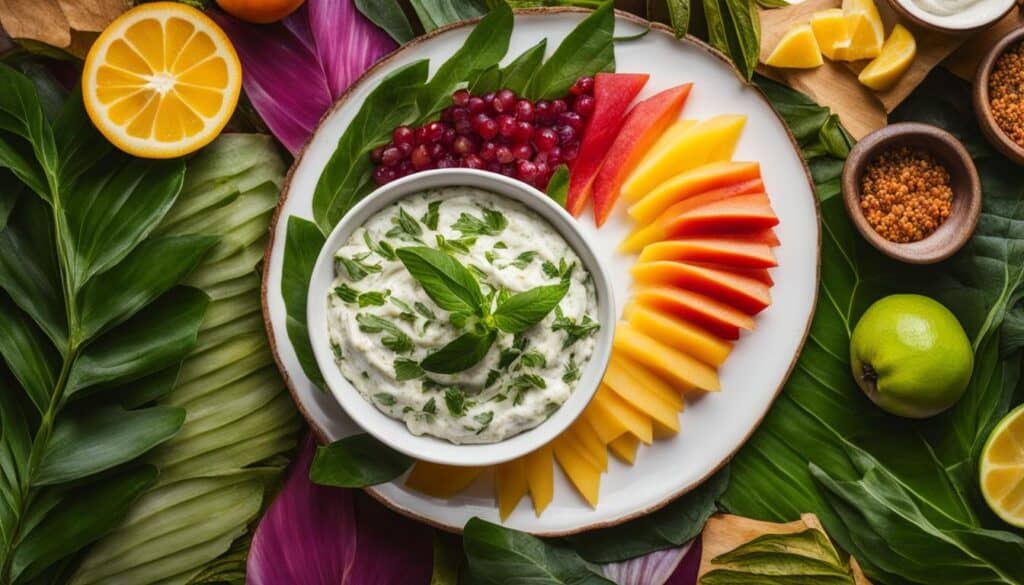
| Dish | Country | Description |
|---|---|---|
| Adobo sa Kamachile | Philippines | A savory dish where camachile pods are added to the classic adobo recipe, infusing the dish with a delightful tang. |
| Agua de Camachile | Mexico | A refreshing beverage made with camachile pods, offering a sweet and tangy taste that quenches your thirst. |
| Camachile Candies | Mexico | Sweet treats made with camachile pods, providing a delightful blend of sweet and sour flavors. |
Conclusion
Camachile’s presence in local cuisines across tropical regions highlights its versatility and delicious flavor. From savory meat dishes to refreshing beverages and sweet treats, camachile adds a tropical twist to traditional recipes, captivating food enthusiasts and delivering an authentic culinary experience.
Camachile’s Environmental Impact: A Sustainable Choice
When it comes to making sustainable choices, camachile farming stands out as an eco-friendly option. By supporting the cultivation of camachile trees, consumers can contribute to positive environmental impacts and promote a greener planet.
One of the significant environmental benefits of camachile farming is its ability to prevent soil erosion. Camachile trees have a dense root system that helps stabilize the soil, reducing the risk of erosion caused by heavy rainfall or wind. This root system also aids in conserving water by preventing runoff and allowing the soil to retain moisture.
Furthermore, camachile trees provide habitat for various wildlife species, promoting biodiversity. The vibrant green foliage and attractive yellow flowers of the camachile tree attract pollinators such as bees and butterflies, supporting their populations. This, in turn, contributes to the overall health of ecosystems and helps maintain a balance in nature.
Perhaps one of the most remarkable contributions of camachile farming to the environment is its ability to sequester carbon dioxide. Like other trees, camachile trees absorb carbon dioxide from the atmosphere during photosynthesis and store it as carbon in their biomass. This process helps mitigate climate change by reducing the concentration of greenhouse gases that contribute to global warming.
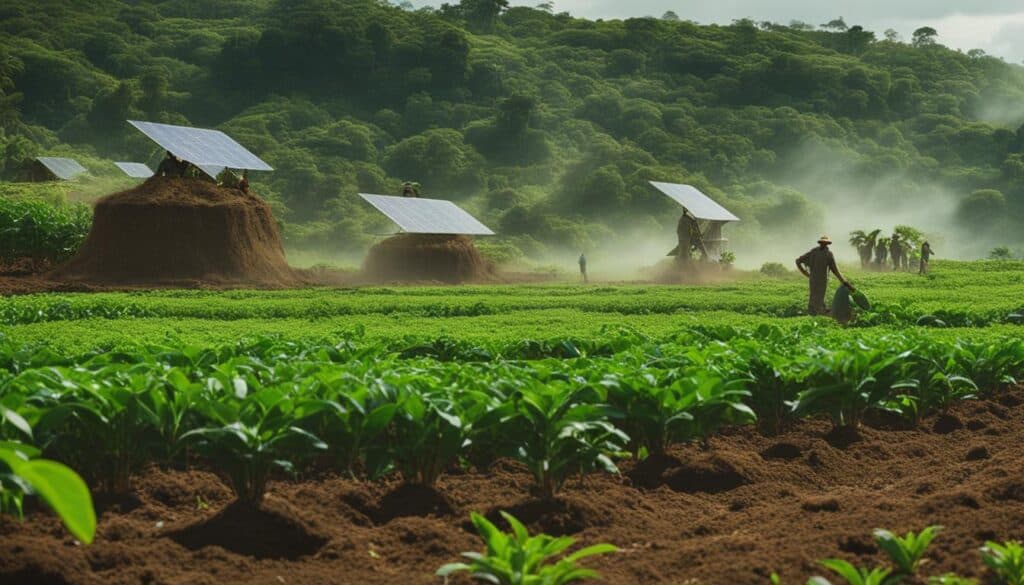
The Environmental Benefits of Camachile Farming:
| Environmental Benefit | Description |
|---|---|
| Prevention of Soil Erosion | The dense root system of camachile trees helps stabilize the soil, reducing the risk of erosion caused by heavy rainfall or wind. |
| Conservation of Water | Camachile trees prevent runoff and allow the soil to retain moisture, conserving water resources. |
| Promotion of Biodiversity | The camachile tree’s foliage and flowers attract pollinators, supporting their populations and contributing to the overall health of ecosystems. |
| Carbon Sequestration | Camachile trees absorb carbon dioxide from the atmosphere and store it, helping mitigate climate change by reducing greenhouse gas concentrations. |
Camachile farming brings together the delicious tropical fruit and sustainable agricultural practices, making it a win-win situation for both consumers and the environment. By choosing camachile products, individuals can enjoy the delightful flavors while actively supporting a greener and more sustainable future.
Camachile in the Global Market: A Rising Star
Camachile, with its unique flavor and versatility, is gaining popularity in the global market. This tropical fruit, known for its tangy and slightly sweet taste, is captivating the taste buds of people from various countries. The demand for camachile is on the rise, paving the way for its emergence as a rising star in the global culinary scene.
With its tropical appeal, camachile is being exported to different countries, offering economic opportunities for farmers and contributing to international trade. Its export is not only benefiting the local farmers but also introducing the delightful flavors of camachile to a wider audience. As more people around the world discover the wonders of camachile, its global market presence continues to grow.
The Growing Popularity of Camachile
Camachile’s growing popularity can be attributed to its unique taste and versatility in various culinary creations. It is being incorporated into both sweet and savory dishes, ranging from jams and desserts to refreshing beverages and exotic sauces. The tangy flavor of camachile adds a delicious twist to traditional recipes and brings a tropical touch to global cuisine.
Camachile’s rise in the global market reflects its potential to become a sought-after ingredient, captivating the palates of food enthusiasts worldwide.
As camachile continues to make its mark on the global stage, its appeal extends beyond its taste. The fruit is also recognized for its numerous health benefits, making it a favorite among health-conscious consumers. With its high fiber content, antioxidants, and essential vitamins and minerals, camachile offers a nutritional powerhouse in addition to its delightful flavor.
| Benefits of Camachile in the Global Market | Highlights |
|---|---|
| Increasing demand | The rising popularity of camachile is driving an increase in demand from consumers around the world. |
| Economic opportunities | Camachile’s export provides economic opportunities for local farmers and contributes to international trade. |
| Unique flavor | The tangy and slightly sweet taste of camachile sets it apart from other tropical fruits, making it an appealing choice for culinary experimentation. |
| Health benefits | Camachile is not only delicious but also packed with essential nutrients, offering a healthy and flavorful option for consumers. |
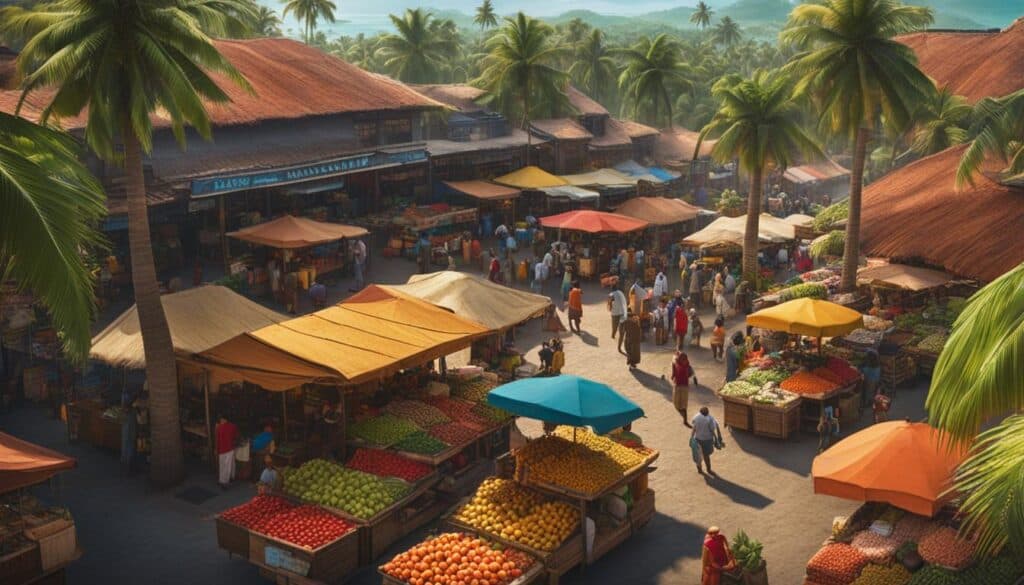
As camachile continues to make its presence felt in the global market, it is poised to become a staple in international cuisine. Its rising popularity, economic opportunities, and unique flavor contribute to its status as a rising star. Whether enjoyed fresh, incorporated into dishes, or exported to different countries, camachile is set to captivate the taste buds of people around the world.
Camachile Farming Communities: Empowering Local Farmers
Camachile farming plays a vital role in empowering local communities by providing income and livelihood opportunities for small-scale farmers. These farming communities are the backbone of camachile production, ensuring that this tropical delight reaches the global market. By supporting camachile products, consumers can contribute to the economic empowerment of these communities and help improve their quality of life.
One of the significant benefits of camachile farming is the creation of job opportunities. Small-scale farmers plant, cultivate, and harvest camachile trees, creating employment for themselves and others in the community. This not only boosts the local economy but also helps in poverty alleviation by providing a sustainable source of income for farmers and their families.
| Farming Community Benefits | Impact |
|---|---|
| Income Generation | Provides a sustainable source of income for farmers and their families. |
| Community Development | Creates opportunities for community development through infrastructure and education. |
| Sustainable Agriculture | Promotes sustainable agricultural practices and reduces environmental impact. |
Moreover, camachile farming also contributes to community development. The income generated from camachile production can be invested in local infrastructure projects, such as schools, healthcare facilities, and roads. This not only improves the living conditions of the farming communities but also enhances the overall development of the region.
Additionally, camachile farming promotes sustainable agriculture practices. Many farmers embrace organic and environmentally friendly farming methods, minimizing the use of harmful chemicals and pesticides. This helps preserve the natural ecosystem and promote biodiversity in the region. By supporting camachile products, consumers can indirectly contribute to sustainable farming practices and a greener environment.
Camachile’s Journey: From Tree to Table
The production process of camachile involves several stages, from the cultivation of the trees all the way to the final product on your table. Understanding this journey can deepen your appreciation for this tropical delight.
Growing Camachile Trees
The first step in the production process is the cultivation of camachile trees. These trees require a warm climate and well-drained soil to thrive. Farmers carefully select suitable locations and plant the camachile seeds either in containers or directly in the ground. With regular watering and adequate sunlight, the trees begin to grow and develop.
Over the years, the camachile trees reach maturity and start bearing fruits. It’s an exciting moment for farmers as they see the results of their hard work and patience. The vibrant green foliage and attractive yellow flowers of the camachile tree create a beautiful sight.
Harvesting and Processing
Once the camachile fruits are ripe, they are ready for harvest. Farmers carefully handpick the fruits, ensuring that only the best quality ones are selected. The harvested fruits are then cleaned to remove any dirt or debris.
After the cleaning process, the camachile fruits are sorted based on their size and ripeness. This ensures consistency in the final product. Some fruits may be set aside for fresh consumption, while others are processed into various camachile products.
Creating Camachile Products
Camachile fruits can be used to create a wide range of products, including jams, jellies, desserts, and beverages. The fruits are processed to extract their flavorful pulp, which is then used as an ingredient in these delicious treats.
The processing methods may vary depending on the intended product. For example, the pulp may be cooked down to create a thick jam or pureed for a smooth jelly. In the case of beverages, the pulp can be mixed with water, sugar, and other ingredients to create a refreshing drink.

From tree to table, each step in the production process contributes to the delightful camachile experience. Whether you enjoy camachile fruits fresh or as part of a delicious dish, you can savor the tropical flavors and appreciate the effort that goes into bringing this unique fruit to your plate.
Conclusion
Camachile, a tropical fruit known for its unique flavor and versatility, is truly a delight for fruit lovers. With its numerous health benefits and the ability to be used in a variety of dishes, camachile offers a world of tropical flavors to explore.
Whether you choose to grow your own camachile tree or indulge in local cuisines that feature this tropical delicacy, camachile is sure to satisfy your taste buds. Its tangy and slightly sweet flavor adds a delightful twist to both sweet and savory dishes, making it a versatile ingredient in the culinary world.
Not only is camachile delicious, but it also packs a nutritional punch. This tropical fruit is a good source of dietary fiber, antioxidants, vitamins, and minerals. By incorporating camachile into your diet, you can support a healthy gut, boost your immune system, and improve your overall well-being.
Embrace the delights of camachile and let this tropical treat take you on a flavorful journey. Whether you enjoy it fresh, in jams and desserts, or explore its use in traditional medicine, camachile is a true tropical treasure that is worth savoring.
FAQ
What is camachile?
Camachile is a tropical fruit that offers a unique and delightful flavor.
How is camachile used in cooking?
Camachile can be eaten fresh, added to salads, or used as an ingredient in jams, jellies, and desserts. It adds a tangy and slightly sweet flavor to both sweet and savory dishes.
What are the health benefits of camachile?
Camachile is a good source of dietary fiber and contains antioxidants, vitamins, and minerals that contribute to a strong immune system and improved bone health.
Can camachile be used for medicinal purposes?
Camachile has been used in traditional medicine for its anti-inflammatory and antimicrobial effects. However, it’s important to consult with a healthcare professional before using camachile for medicinal purposes.
How can I grow my own camachile tree?
Camachile trees require a warm climate and well-drained soil. The seeds can be planted in containers or directly in the ground, and with proper care, the tree will bear fruit in a few years.
What are some traditional dishes that use camachile?
Camachile is commonly used in traditional dishes such as jams, chutneys, and desserts. In the Philippines, it is often combined with meat in savory dishes, while in Mexico, it is used to make beverages and candies.
What is the environmental impact of camachile farming?
Camachile trees help prevent soil erosion, conserve water, and provide habitat for wildlife. They also sequester carbon dioxide from the atmosphere, contributing to mitigating climate change.
Is camachile popular in the global market?
Camachile is gaining popularity in the global market due to its unique flavor and versatility. It is exported to various countries, providing economic opportunities for farmers and contributing to international trade.
How does camachile farming support local communities?
Camachile farming provides income and livelihood opportunities for small-scale farmers, helping them improve their quality of life and promote sustainable agricultural practices.
What is the journey of camachile from tree to table?
The journey involves the cultivation of camachile trees, the harvesting of ripe fruits, and the cleaning, sorting, and processing of the fruits into various products or selling them fresh in local markets.

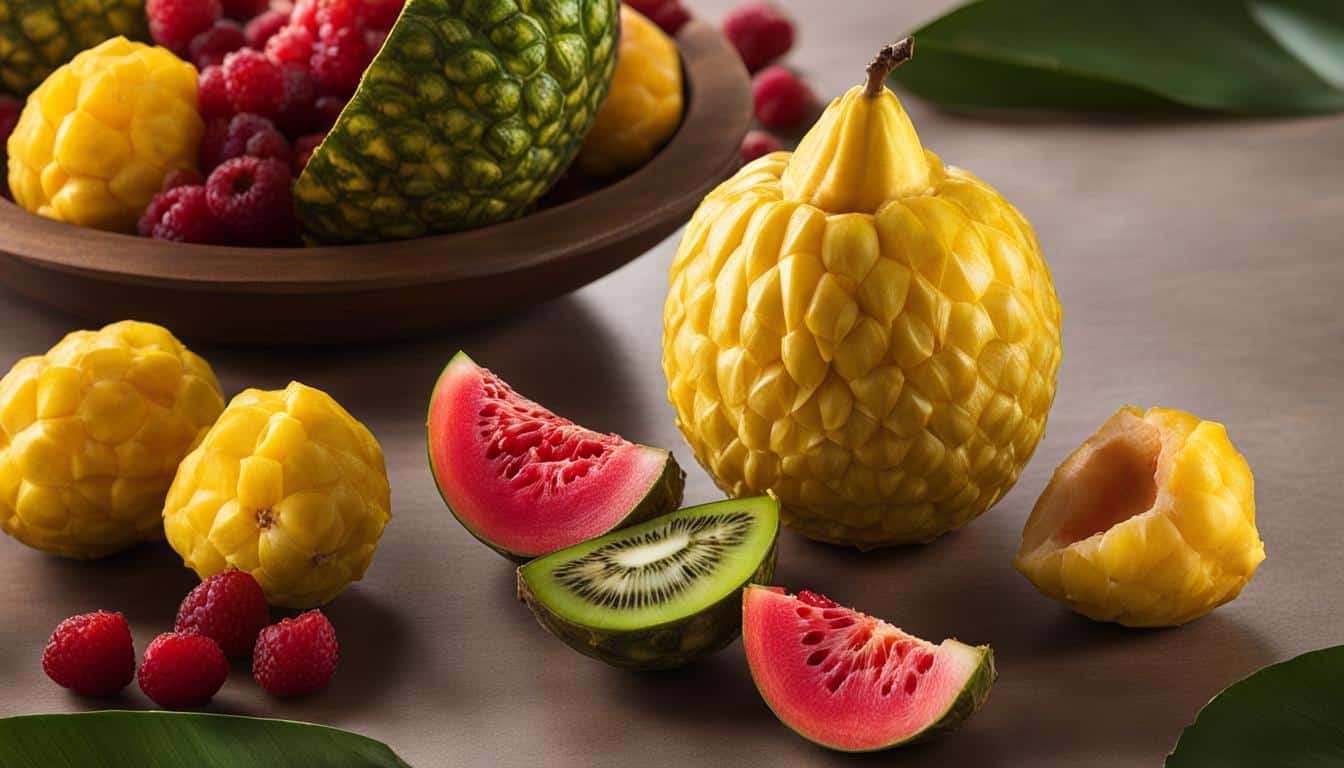



Leave a Reply